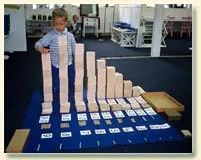Ten Secrets of Montessori Education
Check back at our What's New! Age of Montessori blog site each week.
Read about The Ten Secrets of Montessori Education and find out what these secrets can mean to you and your work with children. Following the series on The Ten Secrets, you will have the opportunity to learn more about the four major avenues of Montessori education and much more.
With these ten secrets you will gain insights into the heart of the international phenomenon of Montessori education. Maria Montessori brought more than a method with Montessori education; she brought a message. These ten secrets are based on her long years of observing children and determining what they needed to thrive. Yet Montessori education is far broader than a recipe for schools for little children.
 1. Two poles of humanity
1. Two poles of humanity

Human development passes through two essential states with very different and distinct shapes and goals. She called this “the two poles” of humanity. The child works for the pure pleasure of activity, to satisfy himself, while the adult works to accomplish some external end. This essential difference is largely unnoticed by adults, and civilization is based almost entirely on the needs of its adult members.
2. Help to life
Montessori brings an entirely new vision of the role and function of education. She sees education as “help to life.” She writes:
Education is not what the teacher gives; education is a natural process spontaneously carried out by the human individual.
3. The absorbent mind
Montessori coined “the absorbent mind” to describe the first six years of life when the child has an unparalleled learning capacity. During this period the child learns effortlessly though simple interactions in the environment. At the ages of about six to seven the absorbent mind fades away and is replaced by the reasoning mind, the mind we as adults use to live and learn.
4. Sensitive periods
In the early years of life, development passes through intense periods where the child manifests a desire to do very specific things to assist her interior development. Each step in development has its own time, whether learning to walk, talk or build a tower. In Montessori we take advantage of these periods with carefully designed materials.
5. Individual differences
Each child is different. There is nothing in child development research that would suggest that all 3-year-olds or 4-year-olds or children of any age will need the same lesson at the same time, yet this is exactly what traditional schooling does.
Montessori education offers an organized way to provide each child what he needs when he needs it. No one is pushed, yet all is possible.
 6. Prepared environment
6. Prepared environment

Montessori educational furniture and implements are all in proportion to the child. There is no teacher’s desk. The environment is filled with age appropriate material designed to facilitate all areas of development. The child engages with both physical and mental activity that provides the perfect match of external activity with sensitive periods.
7. Freedom of choice
In Montessori education, each morning when a child comes to the Montessori classroom, she says hello, puts her things away and goes to work of her choice. She is free to select any lesson she has been shown how to use. She may ask for new lessons. She may work at a table or on the floor, by herself or with a friend. She may work as long as she wishes until the work period ends.
8. Liberty and discipline
Liberty and discipline are two sides of the coin. They are so co-related that Montessori found that if there is lack of discipline, the cause is generally lack of freedom. When the child is working and concentrating, he is naturally exerting self-discipline of a kind no adult can command. The child who is not free to follow his inner directives may act out in naughtiness and tantrums.
9. Normalization
Normalization, which is the calming, centering and accelerating of the child’s development, always takes place through work. The prepared environment removes obstacles to the child becoming normalized, providing opportunity for concentration and work, catalysts for normalization.
10. Spontaneous joy
When Montessori education is rightly understood and children are developing to the fullest of their potential, the natural result is joy. If you do not see spontaneous joy in a Montessori school, you are not seeing the real thing.




















